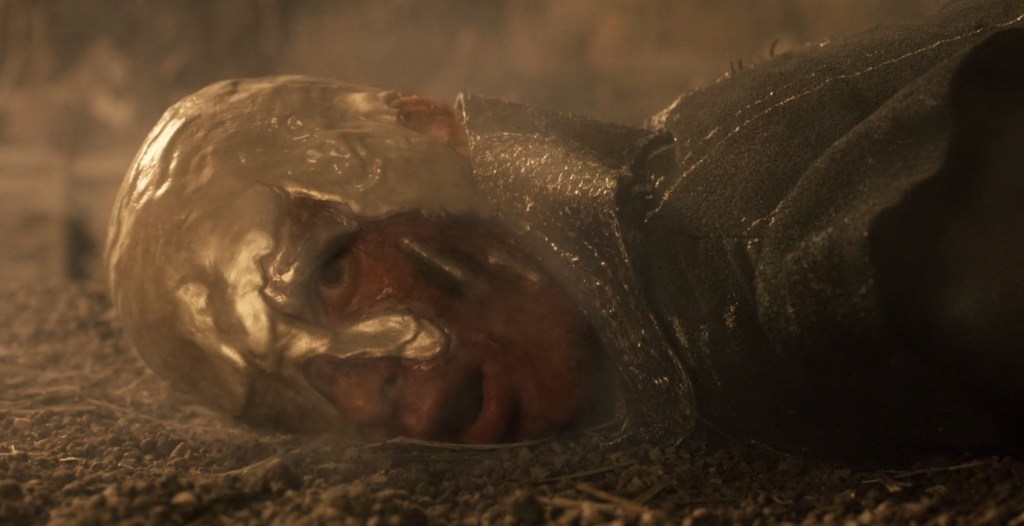
In its early days, Game of Thrones was revered for its subtlety and cleverness, and even on multiple re-watches, new Easter eggs come to light. Episode titles often were easy to overlook when the show was airing on cable, but revisiting it now on Blu-ray, each one stands out and adds new meaning to the story. This time around, I had an epiphany watching Season 1, Episode 6, “A Golden Crown.” The title obviously refers to the fate of Viserys Targaryen in Vaes Dothrak, but it also relates directly to Ned Stark’s business over in King’s Landing. Read on for a look back at how these two stories come together and compliment each other in hindsight.
WARNING: There are spoilers for Game of Thrones ahead!
Past the halfway point of Season 1, the story really begins to heat up on all fronts. After finishing this episode, you’d likely relate this title the climactic scene that ends the episode — Khal Drogo murdering Viserys in Vaes Dothrak. The one and only permanent settlement of the Dothraki, Vaes Dothrak is considered a sacred place, and it’s illegal to either carry a weapon or spill blood there.

When Viserys threatens his sister and her husband the Khal, Drogo finds a unique way to kill him without any bloodshed. Viserys believes he that Drogo owes him an army as Daenerys’ dowry, and he is impatient to sail across the Narrow Sea and re-conquer Westeros for House Targaryen. He is constantly complaining about the crown that he is entitled to, so Drogo gives it to him. While Viserys is restrained, Drogo melts several pieces of gold in a nearby cauldron, then upends it over the princes head. Molten gold runs over Viserys’ face, and after a few agonized screams, he dies.
[RELATED: The 10 Best Game of Thrones Battle Episodes]
That’s the most obvious meaning of this episode title, but it clearly refers to another major revelation earlier in this episode back in King’s Landing. There, the Hand of the King Ned Stark continues his investigation into how his predecessor and mentor, Jon Arryn, was killed. He has already learned that Arryn was investigating King Robert Baratheon’s bastard children, and now he takes a look at the books Arryn was studying at the time of his death.
Ned reads aloud from a book of Baratheon family history, slowly realizing that the Baratheon genes take over the appearance of everyone who comes from the family. These features show up in Robert’s bastard children as well, yet all three of his children with Queen Cersei look more like Lannisters — with distinct gold hair and fair features. This, along with Arryn’s last words “the seed is strong,” leads Ned to the conclusion that Cersei’s children were secretly fathered by her twin brother Jaime, not the king, meaning they have no rightful claim to the throne.
Double Meaning of “A Golden Crown”

“A Golden Crown” is a fitting reference to this revelation because the Lannisters’ hair is frequently described as gold — not blond. It’s a very distinct feature of their house, and it’s never been shown in Baratheon genes. This leads Ned to confront the queen, and to stay in King’s Landing to help his friend rather than returning to Winterfell as he had planned.
It’s clever to draw attention to the parallels between these two stories, because once you notice it, they dovetail very nicely. Both are about the difference between a symbol of power like a crown, and true power, which means raw violent force in Westeros. Viserys’ royal lineage does not protect him when he lashes out in Vaes Dothrak, and Ned realizes that Robert’s children are not true-born royalty even if they give every appearance that they are.
On a lighter note, both of these plot points are popular jokes within the fandom. Ned’s narration of the Baratheon family history sometimes circulates on social media with a Punnett square superimposed over it, along with other jokes mocking the Westerosi understanding of genetics. However, this understanding of how traits are passed down is important in George R.R. Martin’s work, and it plays into the story later when it comes to magical genes like warging and dragon-riding.
Meanwhile, fans love to poke fun at the scene of Viserys’ death. Many have calculated how long it would actually take for the gold jewelry to melt over an open cookfire, noting that it would take a lot of the drama and suspense out of the moment. It probably wouldn’t actually melt at all without a proper forge.
Game of Thrones was great at these kinds of subtle double-meanings early on, reinforcing the parallels that Martin had already drawn in his books. Season 1 especially reflected the over-arching narrative of all these disparate storylines and the potential for them to come together in one grand climax back in Westeros. The showrunners had a very strong grasp of all the inner working of the story through the first three books, but beyond that, their adaptation became much more loose. By the time their story exceeded Martin’s books, it had already changed drastically from the written material.
Still, Game of Thrones is easy to re-watch because once you know where the story is going, foreshadowing and Easter eggs continue to jump out like this. The same is true of the books, which are even more fun to re-read with fresh eyes. The show is streaming now on Max, while the books are available in print, digital, and audiobook formats. The next spinoff, A Knight of the Seven Kingdoms, premieres later this year on HBO and Max.
The post I Just Realized That This Game of Thrones Episode Has a Double Meaning appeared first on ComicBook.com.

